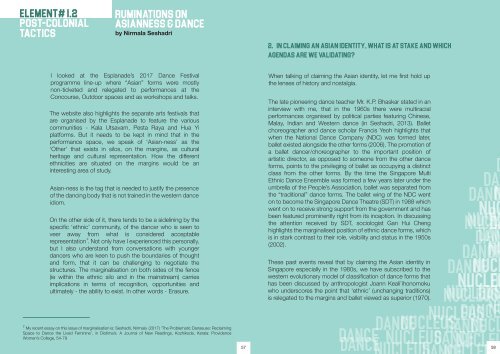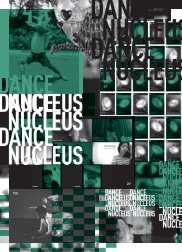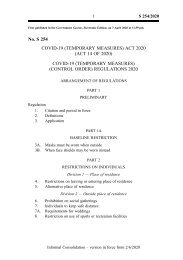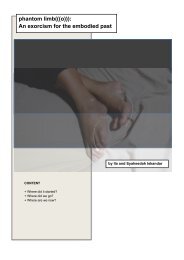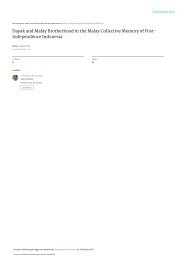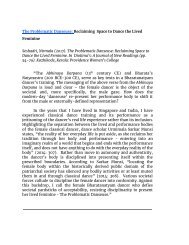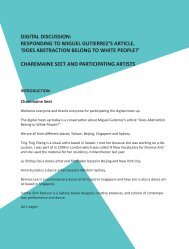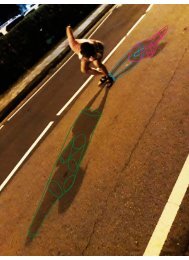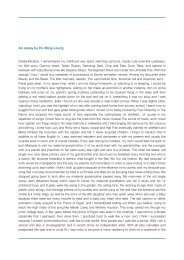FUSE#1
FUSE is a bi-annual publication that documents the projects at Dance Nucleus
FUSE is a bi-annual publication that documents the projects at Dance Nucleus
You also want an ePaper? Increase the reach of your titles
YUMPU automatically turns print PDFs into web optimized ePapers that Google loves.
Element# 1.2<br />
Post-Colonial<br />
Tactics<br />
Ruminations on<br />
asiaNness & Dance<br />
by Nirmala Seshadri<br />
2. In claiming an Asian identity, what is at stake and which<br />
agendas are we validating?<br />
I looked at the Esplanade’s 2017 Dance Festival<br />
programme line-up where “Asian” forms were mostly<br />
non-ticketed and relegated to performances at the<br />
Concourse, Outdoor spaces and as workshops and talks.<br />
The website also highlights the separate arts festivals that<br />
are organised by the Esplanade to feature the various<br />
communities - Kala Utsavam, Pesta Raya and Hua Yi<br />
platforms. But it needs to be kept in mind that in the<br />
performance space, we speak of ‘Asian-ness’ as the<br />
‘Other’ that exists in silos, on the margins, as cultural<br />
heritage and cultural representation. How the different<br />
ethnicities are situated on the margins would be an<br />
interesting area of study.<br />
Asian-ness is the tag that is needed to justify the presence<br />
of the dancing body that is not trained in the western dance<br />
idiom.<br />
On the other side of it, there tends to be a sidelining by the<br />
specific ‘ethnic’ community, of the dancer who is seen to<br />
veer away from what is considered acceptable<br />
2<br />
representation . Not only have I experienced this personally,<br />
but I also understand from conversations with younger<br />
dancers who are keen to push the boundaries of thought<br />
and form, that it can be challenging to negotiate the<br />
structures. The marginalisation on both sides of the fence<br />
(ie within the ethnic silo and in the mainstream) carries<br />
implications in terms of recognition, opportunities and<br />
ultimately - the ability to exist. In other words - Erasure.<br />
When talking of claiming the Asian identity, let me first hold up<br />
the lenses of history and nostalgia.<br />
The late pioneering dance teacher Mr. K.P. Bhaskar stated in an<br />
interview with me, that in the 1960s there were multiracial<br />
performances organised by political parties featuring Chinese,<br />
Malay, Indian and Western dance (in Seshadri, 2013). Ballet<br />
choreographer and dance scholar Francis Yeoh highlights that<br />
when the National Dance Company (NDC) was formed later,<br />
ballet existed alongside the other forms (2006). The promotion of<br />
a ballet dancer/choreographer to the important position of<br />
artistic director, as opposed to someone from the other dance<br />
forms, points to the privileging of ballet as occupying a distinct<br />
class from the other forms. By the time the Singapore Multi<br />
Ethnic Dance Ensemble was formed a few years later under the<br />
umbrella of the People’s Association, ballet was separated from<br />
the “traditional” dance forms. The ballet wing of the NDC went<br />
on to become the Singapore Dance Theatre (SDT) in 1988 which<br />
went on to receive strong support from the government and has<br />
been featured prominently right from its inception. In discussing<br />
the attention received by SDT, sociologist Gan Hui Cheng<br />
highlights the marginalised position of ethnic dance forms, which<br />
is in stark contrast to their role, visibility and status in the 1950s<br />
(2002).<br />
These past events reveal that by claiming the Asian identity in<br />
Singapore especially in the 1980s, we have subscribed to the<br />
western evolutionary model of classification of dance forms that<br />
has been discussed by anthropologist Joann Keali’ihonomoku<br />
who underscores the point that ‘ethnic’ (unchanging traditions)<br />
is relegated to the margins and ballet viewed as superior (1970).<br />
2<br />
My recent essay on this issue of marginalisation is: Seshadri, Nirmala (2017) ‘The Problematic Danseuse: Reclaiming<br />
Space to Dance the Lived Feminine’, in Diotima’s: A Journal of New Readings, Kozhikode, Kerala: Providence<br />
Women’s College, 54-79<br />
57 58


